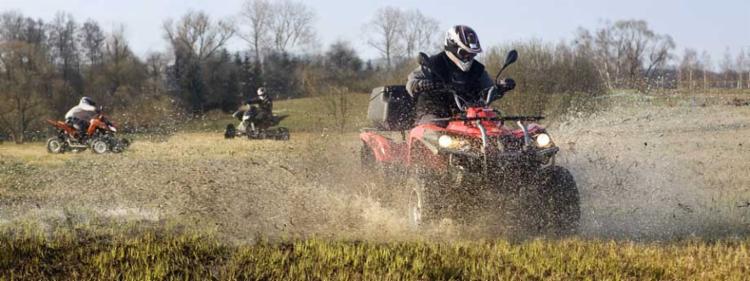6 ATV Safety Tips Big Game Hunters Should Know

All-terrain vehicles have become so popular with hunters over the last 20 years that many of the latest four-wheel drive models are specially designed to meet the rugged demands of big game hunters. Quieter engines, beefed-up suspension systems, tougher tires, camouflage wraps and hunting accessory packages are the new game in the outdoorsman ATV market.
But along with the increased accessibility to steep, rocky terrain afforded by these powerful machines comes a greater risk of accident and personal injury.
The safe operation of your ATV on hunting trips involves many factors, ranging from how you store and transport your firearms on the vehicle to how well you know how to drive the machine. With hunting season in full swing across much of the country, it is my hope that the following safety tips will help you have a fun, successful and accident-free hunt this season and in the years ahead. Just make sure you're covered with affordable ATV insurance.
Always Wear Protective Gear
The gear you wear while driving your ATV can save you from serious injury in the event of an accident, such as a flip over while going over large obstacles on the trail. Most importantly, you should always wear:
- Helmet: Some hunters may scoff at the idea of wearing a helmet, believing that it will restrict their ability to “eyeball” the terrain for game. Sure, you might miss the flash of a whitetail or the sun’s reflection off an antler because of a helmet, but you could also save yourself a serious crack on the head if you lose control and flip the ATV over. Be smart and wear your helmet at all times while driving in your hunt area.
- Appropriate clothing: Chances are the weather will be chilly when you’re hunting, so wearing long sleeves, a jacket and boots goes pretty much without saying. But I recommend dressing in layers in case the weather warms up. There are usually other hunters in the same area, so wear an orange hunting vest. You just never know when some inexperienced, overeager hunter will take aim at the sudden movement of a vehicle through the brush or timber—especially if the driver is fully camouflaged and driving a camo-wrapped ATV.
ATV Gun Safety
A loaded gun can easily discharge when you are bouncing around on a rough trail. So for your safety and that of others, always double-check to make sure your guns are unloaded before heading out in your ATV.
- Unload it: Remove ammo clips and empty the magazines of your guns, then secure them to the ATV in a hard case or scabbard before driving out to your hunt. If you carry a sidearm, make sure the chamber is empty and the safety is on before holstering the weapon.
- Don’t shoot it: As with other vehicles, it is illegal in all states to shoot from an ATV at any time. Your ATV is only a means of getting you to your hunting area—it is not a shooting platform. If you do spot a big buck from the trail, park the ATV and quietly walk to where you can get a clean shot. Never shoot across a trail, road, stream, or lake.
- Don’t carry it: Carrying your rifle or shotgun strapped over your shoulder while driving your ATV is a bad idea. The barrel can snag on low tree branches and brush, or worse, a small branch could lodge in the trigger guard, causing the gun to fire if you failed to empty the chamber.
Take a Safety Course
According to the U.S. Consumer Product Safety Commission ATV Safety Report, 107,900 ATV-related emergency injury treatments were reported in 2012, 25% (26,500) of which involved children under the age of 16. The CPSC also reports that fewer than 10% of all ATV drivers have ever bothered to take a training course and only 25% of new ATV drivers have taken a course.
Learning to safely drive an ATV isn’t easy for most people. Besides learning how to shift their body weight to make turns, drivers need to learn how to operate the ATV in different soil and terrain conditions. For example, maneuvering an ATV on a rough mountain trail can be a challenge for someone whose only driving experience has been in sand dunes.
Never let a child ride with you or drive an adult model ATV—almost 33% of ATV-related injuries and deaths in the last 20 years have been riders and drivers under the age of 16.
As an experienced ATV driver who has had his own share of spills, I have great respect for the dangerous side of these machines. I recommend that all ATV drivers, especially young and inexperienced ones, take the ATV Safety Institute’s Rider Safety Course. You may also qualify for an insurance discount by taking the course.
Trail Obstacles and Streams
ATV-designated backcountry trails often have large rocks and holes or are divided by streams. Slow down and carefully maneuver your ATV over obstacles, and never go off the trail to bypass them. It is illegal to drive off the trail on public land, and besides that, you don’t know what hazards may be hidden in the tall grass, underbrush or snow alongside the trail.
Always cross over streams by following the designated route so you don’t drop off into a deep hole. If you’re hunting on private land (always get permission first!), ask the landowner about any streams you may encounter and where it’s best to ford them.
Be Prepared
Any number of things can happen when you are ATVing into your hunting area. Mechanical breakdowns, injuries and getting lost can happen to anyone on the trail. You should have the following items in a pack secured to the back of your machine.
- Survival kit:This should include enough food to sustain you for 48 hours—longer if you’re in a very remote area. The kit should also contain an emergency survival blanket, a map of the area you’re in, a small LED flashlight, a compass, waterproof matches or a fire starter and a portable water filter bottle.
- First aid kit: Minor injuries are going to happen. Keep your kit supplied with some antiseptic ointment, bandages, tweezers, insect repellent and pain pills.
- Tool kit: Most ATVs come with a basic tool kit that includes pliers, a few wrenches and a spark plug wrench. It’s a good idea to add a couple of fuses and a roll of electrical tape to your kit as well.
- Communication: It’s unlikely you’ll have cell service in the backcountry, so a GPS satellite messenger device can be a lifesaving tool in the event you get lost or injured.
Don’t Go Hunting Alone
No matter what kind of hunting you’re doing, it’s always safest to hunt with a friend or in a group. It is too easy to lose your bearings and get lost when you are alone in an unfamiliar area. You could also be injured by an ATV accident or other mishap and be unable to walk or care for yourself.
Aside from the safety factor, ATVing the backcountry and hunting are always more fun if someone else is along to share the experience. Regardless of whether you go alone, with a friend, or as part of a group, always let someone at home know exactly what area you’ll be hunting in before setting out.
ATVs have become almost as popular as precision firearms among hunters. While there are inherent risks to operating an ATV, the reward is great in terms of riding enjoyment while on your hunting trip. As one final safety tip, check with your independent agent to make sure your machine is fully covered with ATV insurance and ready to go to keep your next hunting adventure safe and fun.
